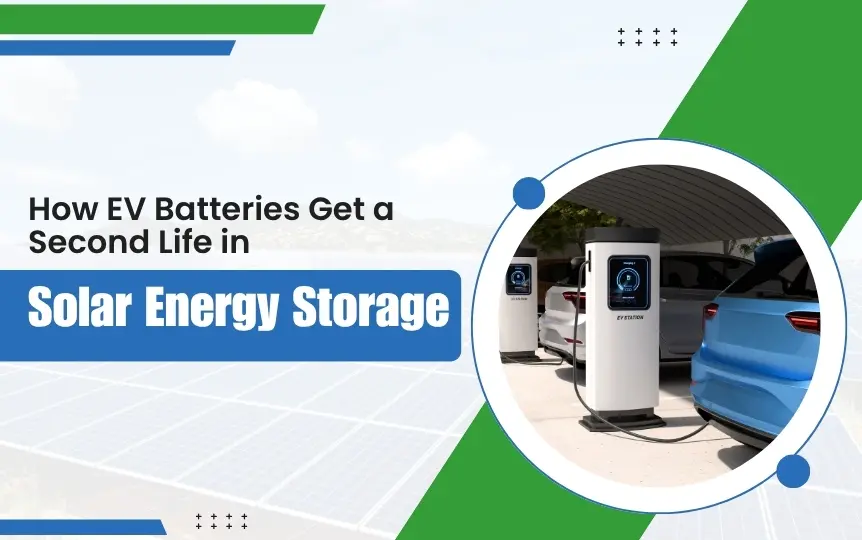Introduction
With the rapid growth of electric vehicles (EVs), the world faces a new kind of sustainability challenge: what happens to EV batteries once their life on the road ends? The answer lies in an innovative solution revolutionizing renewable energy—repurposing used EV batteries for solar energy storage. This blog explores how this exciting approach not only addresses battery waste but also amplifies the benefits of solar energy, contributing to a cleaner and more efficient future.
The Life Cycle of EV Batteries
EV batteries work hard. Over time, their ability to store energy gradually declines due to repeated charging and discharging cycles. When an electric car battery drops to about 70–80% of its original capacity, it’s no longer optimal for vehicle performance. However, these batteries aren’t spent—they still retain enough capacity for applications less demanding than driving.
Why Consider a Second Life?
-
- Reduces waste: Prolongs battery life, keeping them out of landfills.
- Cuts costs: Reusing batteries is more economical than new storage solutions.
- Conserves resources: Delay the need for mining and manufacturing fresh battery materials.
- Boosts renewable energy: Makes solar adoption even more practical for homes and businesses.
What Makes EV Batteries Suitable for Solar Storage?
Unlike vehicles, solar energy storage doesn’t require batteries to deliver high bursts of power or withstand extreme conditions. Instead, the main requirement is sustained, reliable storage of energy generated during the day for use at night or during cloudy periods.
Repurposed EV batteries excel at:
-
- Storing and releasing moderate levels of energy over longer periods.
- Handling regular charge-discharge cycles from solar generation.
- Providing scalable solutions for both home and commercial solar systems.
How Does the Battery Repurposing Process Work?
Giving EV batteries a second life involves several key steps:
- Collection and Evaluation: Used EV batteries are retrieved and assessed for health, remaining capacity, and safety.
- Reconditioning: Weak or damaged cells are replaced, and the battery is reconfigured as needed for stationary storage.
- Integration: Batteries are installed in solar storage systems, connected with smart inverters and management systems.
- Deployment: The batteries are put to work, storing excess solar energy for use after sundown or during power outages.
EcoGreen Australia’s Role in a Greener Tomorrow
EcoGreen Australia leads the drive for practical, sustainable energy solutions. By combining innovation with hands-on expertise, EcoGreen helps businesses cut costs and reduce emissions—often delivering significant free upgrades and seamless installation. For organizations considering solar adoption, EcoGreen’s tailored approach makes integrating second-life EV battery storage even easier, maximizing ROI and supporting Australia’s journey toward net-zero emissions.
“EcoGreen’s exceptional service and expertise in renewable energy helped us cut energy costs and secure thousands in free upgrades.”
— Mark Collins, CFO, Huntingdale CC
Benefits of Second-Life EV Batteries in Solar Storage
For Businesses
-
- Enhanced energy resilience: Safeguard operations from grid fluctuations or outages.
- Lower energy bills: Store cheap solar energy and use it when grid prices are high.
- Favorable government incentives: Take advantage of rebates and support for renewable energy and battery storage solutions.
For Homeowners
-
- Energy independence: Rely less on the grid, especially during peak hours or blackouts.
- Affordable storage: Second-life batteries often cost less than new ones, making solar plus storage more accessible.
- Reduced carbon footprint: Double down on sustainability by using both clean energy and recycled batteries.
For the Environment
- Conserves rare resources: Retains valuable materials for as long as possible.
- Reduces greenhouse gas emissions: Facilitates greater integration of solar and storage, which further curbs fossil fuel use.
Challenges and Considerations
While the benefits are clear, some technical and regulatory hurdles remain:
- Ensuring the safety and reliability of repurposed batteries through comprehensive testing.
- Adapting electrical standards to accommodate second-life systems.
- Building robust systems for tracking battery provenance and performance.
Globally, research and pilot projects are rapidly advancing quality controls, encouraging industry adoption.
The Future of Solar Energy Storage
As the numbers of retired EV batteries grow, their potential to support solar energy integration becomes even greater. In the near future, expect to see:
-
- Widespread use in commercial and residential solar projects.
- Smart grids dynamically managing second-life batteries for peak demand, grid stabilization, and backup power.
- Partnerships between automakers, battery manufacturers, and energy companies—much like EcoGreen Australia’s collaborations—to accelerate sustainable solutions for communities and businesses.
Conclusion
Repurposing EV batteries for solar energy storage is a game-changer. This approach reduces waste, lowers costs, and gives renewable energy a significant boost, making the switch to solar even more compelling. Companies like EcoGreen Australia are at the forefront, helping organizations and homeowners harness the full potential of this sustainable future—one battery at a time.
If you’re ready to explore solar energy with flexible, cost-effective storage solutions, reach out to EcoGreen Australia. Join the movement that powers business, homes, and our planet—smarter and cleaner than ever before.

